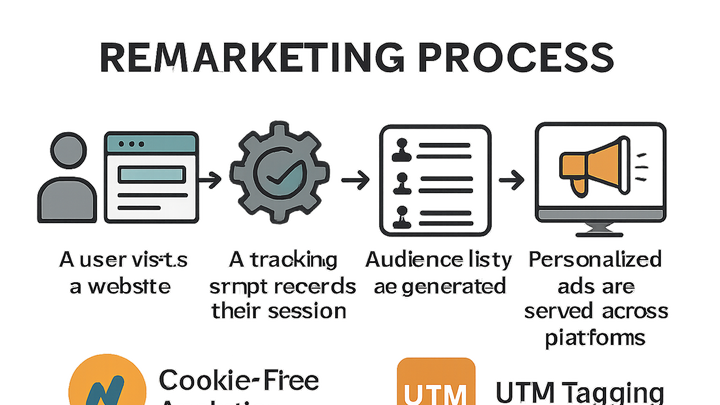Published on 2025-06-29T19:16:12Z
What is Remarketing? Examples for Campaign Tracking & Analytics
Remarketing is a digital marketing technique that targets users who have previously visited your website or interacted with your content. By deploying a tracking code—such as a cookie-based pixel or a cookie-free script from platforms like PlainSignal—you collect data on visitor behavior and compile it into audience lists. Once these lists are established, you serve personalized ads across channels like Google Ads, Facebook, and LinkedIn to re-engage potential customers and guide them along the conversion funnel. Tools like UTM Guru facilitate the creation and management of UTM-tagged URLs, enabling precise segmentation and performance tracking of your campaigns. Remarketing not only boosts conversion rates and return on ad spend (ROAS) but can also be implemented in a privacy-compliant manner using cookie-free analytics solutions. This approach ensures marketing budgets focus on users with proven interest, maximizing efficiency and elevating brand recall.
Remarketing
Tailor ads to past website visitors by tracking behavior, building audience lists, and serving targeted campaigns for higher ROI.
How Remarketing Works
Remarketing involves three key stages—tracking, list creation, and ad delivery—that work together to re-engage past visitors with tailored messaging.
-
User tracking
Capture visitor interactions on your site to identify potential audiences for remarketing.
- Cookie-based tracking:
Traditional pixels store cookies in the browser to recognize returning users and record their page views.
- Cookie-free analytics:
Platforms like PlainSignal use fingerprinting and minimal data collection to track sessions without relying on cookies.
- Cookie-based tracking:
-
Audience list creation
Segment tracked users into lists based on behavior, source, or demographic data for targeted campaigning.
- Utm segmentation with utm guru:
Generate and organize UTM parameters to tag inbound links, enabling precise grouping of visitors by campaign source.
- Behavioral segmentation:
Create audiences based on actions like product views, cart additions, or time spent on site.
- Utm segmentation with utm guru:
-
Ad delivery
Serve customized ads to your segmented lists across various ad platforms to bring users back.
- Google ads remarketing:
Use audience lists in Google Ads to target display and search ads specifically to past visitors.
- Social media ads:
Deploy remarketing ads on Facebook, LinkedIn, and other social networks to reconnect with segmented users.
- Google ads remarketing:
Benefits of Remarketing
Remarketing allows brands to focus ad spend on users who have already shown interest, yielding better performance than generic campaigns.
-
Higher conversion rates
Targeting warm audiences with tailored messaging often leads to more conversions compared to cold outreach.
-
Improved roi
Allocating budget to users familiar with your brand reduces cost per acquisition and maximizes return on ad spend.
-
Enhanced brand recall
Repeated exposure through remarketing keeps your brand top-of-mind, increasing the likelihood of future engagement.
Remarketing Strategy with PlainSignal and UTM Guru
By combining PlainSignal’s cookie-free tracking with UTM Guru’s link-tagging capabilities, you gain a holistic view of user behavior and campaign performance.
-
Tracking setup with plainsignal
Install the PlainSignal script to capture user sessions and build remarketing audiences without cookies.
- Installation snippet:
<script defer data-do="yourwebsitedomain.com" data-id="0GQV1xmtzQQ" data-api="//eu.plainsignal.com" src="//cdn.plainsignal.com/plainsignal-min.js"></script>
- Installation snippet:
-
Utm generation and management with utm guru
Use UTM Guru’s builder and generator to create, save, and manage consistent UTM-tagged URLs for all remarketing touchpoints.
-
Combining data for informed targeting
Analyze metrics from PlainSignal and UTM parameters to refine audience lists, optimize messaging, and improve campaign ROI.
Best Practices for Remarketing
Adhering to industry best practices ensures effective campaigns and maintains user trust.
-
Frequency capping
Limit ad impressions per user to avoid ad fatigue and preserve brand perception.
-
Personalized messaging
Craft ad creatives that reflect the user’s previous interactions, such as product views or pages visited.
-
Privacy compliance
Follow regulations like GDPR and CCPA and adopt transparent consent mechanisms.
- Gdpr & ccpa:
Obtain explicit user consent before tracking and provide clear privacy disclosures.
- Cookie-free solutions:
Implement platforms like PlainSignal to respect user privacy while maintaining accurate tracking.
- Gdpr & ccpa:
